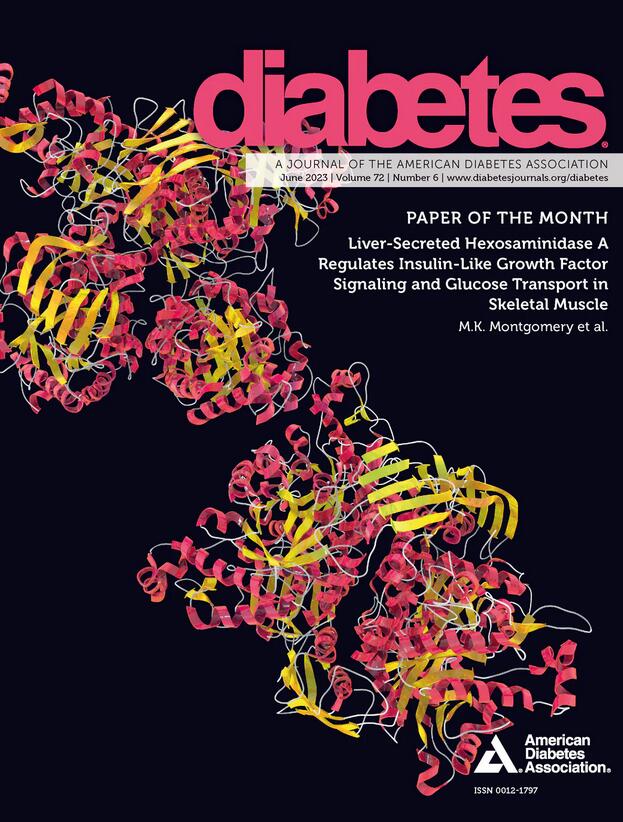脂质参与肾脑GDF15轴抑制食物摄入
IF 7.5
1区 医学
Q1 ENDOCRINOLOGY & METABOLISM
引用次数: 0
摘要
生长分化因子15 (GDF15)是一种厌食和减肥诱导激素,对内质网应激、运动、二甲双胍以及最近的饮食脂质等刺激作出反应。鉴于其作为抗肥胖药物的潜力,我们研究了内源性GDF15如何响应不同器官的脂质内输注来调节体内食物摄入。我们发现急性脂质内输注到上小肠(USI)抑制食物摄入,增加血浆GDF15,以及肾脏和肝脏GDF15的表达,在喂食而不是高脂肪(HF)诱导的贪食雄性大鼠中。肾脏Gdf15敲除减弱了脂质内引起的肾脏和血浆Gdf15水平的升高及其降低摄食的作用,而肝脏Gdf15的表达不受影响。最后,我们在鼠脑后区域敲除GDNF家族受体α-样(Gfral),尽管在鼠血浆中GDF15水平升高,但却否定了脂内酯降低摄食的作用。总之,我们报道肾脏GDF15对于USI脂内传感触发区域后轴抑制食物摄入是必要的。我们认为,HF喂养通过否定肾GDF15的脂质调节作用,损害急性脂质感知从而降低摄食。上小肠脂质输注增加了鼠粮中肾脏、肝脏和血浆中生长分化因子15 (GDF15)的水平,但对高脂大鼠没有影响。上小肠脂质输注降低了大鼠的食物摄取量,但对高脂肪大鼠没有影响。敲低肾Gdf15可抑制脂质,增加血浆Gdf15并降低摄食。术后区域GDNF家族受体α-样(Gfral)的下调可否定脂质厌食作用。本文章由计算机程序翻译,如有差异,请以英文原文为准。
Lipids Engage a Kidney-Brain GDF15 Axis to Suppress Food Intake
Growth differentiation factor 15 (GDF15) is an anorectic and weight-loss–inducing hormone that responds to stimuli such as endoplasmic reticulum stress, exercise, metformin, and more recently, dietary lipids. Given its potential as an antiobesogenic agent, we examined how endogenous GDF15 responds to an Intralipid infusion in different organs to regulate food intake in vivo. We found that an acute Intralipid infusion into the upper small intestine (USI) inhibited food intake and increased plasma GDF15, as well as kidney and hepatic Gdf15 expression in chow-fed but not high-fat (HF)–induced hyperphagic male rats. Kidney Gdf15 knockdown blunted Intralipid-induced increases in kidney and plasma GDF15 levels as well as its feeding-lowering effects, while hepatic Gdf15 expression remained unaffected. Lastly, we knocked down GDNF family receptor α-like (Gfral) in the area postrema, which negated the feeding-lowering effect of Intralipid despite a rise in plasma GDF15 levels in chow rats. In summary, we report that kidney GDF15 is necessary for USI intralipid sensing to trigger an area postrema axis to inhibit food intake. We propose that HF feeding impairs acute lipid sensing to lower feeding by negating the lipid-regulatory effect on kidney GDF15. ARTICLE HIGHLIGHTS Upper small intestine lipid infusion increases kidney, hepatic, and plasma growth differentiation factor 15 (GDF15) levels in chow but not high-fat rats. Upper small intestine lipid infusion lowers food intake in chow but not high-fat rats. Knockdown of kidney Gdf15 negates lipids to increase plasma GDF15 and lower feeding. Knockdown of GDNF family receptor α-like (Gfral) in the area postrema negates lipid anorectic effect.
求助全文
通过发布文献求助,成功后即可免费获取论文全文。
去求助
来源期刊

Diabetes
医学-内分泌学与代谢
CiteScore
12.50
自引率
2.60%
发文量
1968
审稿时长
1 months
期刊介绍:
Diabetes is a scientific journal that publishes original research exploring the physiological and pathophysiological aspects of diabetes mellitus. We encourage submissions of manuscripts pertaining to laboratory, animal, or human research, covering a wide range of topics. Our primary focus is on investigative reports investigating various aspects such as the development and progression of diabetes, along with its associated complications. We also welcome studies delving into normal and pathological pancreatic islet function and intermediary metabolism, as well as exploring the mechanisms of drug and hormone action from a pharmacological perspective. Additionally, we encourage submissions that delve into the biochemical and molecular aspects of both normal and abnormal biological processes.
However, it is important to note that we do not publish studies relating to diabetes education or the application of accepted therapeutic and diagnostic approaches to patients with diabetes mellitus. Our aim is to provide a platform for research that contributes to advancing our understanding of the underlying mechanisms and processes of diabetes.
 求助内容:
求助内容: 应助结果提醒方式:
应助结果提醒方式:


